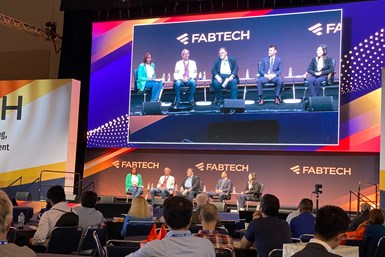Constant Reinvention
Industry events highlight the intersections between areas of manufacturing and the ways today’s industry trends are changing the way things are made.

Advanced manufacturing panel at FABTECH 2023.
Photo Credit: Products Finishing
I keep a list of upcoming events on a chalkboard by my desk. I prefer chalkboards to whiteboards and while I use my Outlook calendar, phone reminders and whatever tech is at my disposal, I still like my handwritten lists. Old school, I guess — or maybe it’s a writer thing. Anyway, that list of events has been both literally and figuratively hanging over me all year — and now it’s upon me. As I write this, I’m attending FABTECH in Chicago. I also just finished up a few days at the SPE Automotive Composites Conference and Exhibition in Novi, Michigan. These days, I’m wearing my two hats as the editor of both Products Finishing and CompositesWorld. And while the worlds of coatings and finishes and the world of composites and advanced materials may seem far apart, at the end of the day, the overarching trends in every market from automotive to aerospace to infrastructure touch all areas of manufacturing.
The SPE ACCE conference put me in the same room with designers and engineers for tier one automotive suppliers and representatives from OEMs. It was interesting to hear about some of the trends that are driving the design and engineering decisions for automakers. Lightweighting, of course, is a big topic for the automotive industry, driven by the growing demand for electric vehicles (EVs) and emerging mobility applications such as advanced air mobility (AAM). Many signs point to aluminum as the most likely lightweight material of choice for automakers for structural components for the near future, but there are also numerous areas where carbon fiber and even natural fibers are used. When it comes to AAM, flying cars and electric vertical take-off and landing (EVTOL) vehicles will rely heavily on composites and 3D printed materials.
What does all of this mean for coaters and finishers?
The mix of substrates that require coatings will continue to evolve. Electroplating has the potential to contribute not only to decorative applications, but also can provide such properties as conductivity, shielding and even enhancing structural properties. Powder coatings can help provide insulative properties in such applications as battery boxes. An important thing to keep in mind is that all of these applications, from EVs to hydrogen fuel cell-powered vehicles to EVTOLs, are still in early iterations. Materials and manufacturing processes are being evaluated and reevaluated at this very moment. The increased production of new energy vehicles (NEVs) of all types presents a whole new set of puzzles to solve for everyone in the automotive supply chain. Various components require conductive or insulative properties and the industry hasn’t fully converged on the solutions that will enable those applications. Constant innovation and iteration are underway as we speak, opening the door for collaboration opportunities with automotive OEMs and tier suppliers.
In addition, all of this innovation is happening at a time when environmental consciousness and the need for sustainable materials and processes are at an all-time high. New regulations are pushing the need for developing and proving new technologies. And new solutions are being developed to meet those challenges. For example, check out the October issue feature from Abrose Schaffer of MacDermid Enthone on reduced ion electroless nickel, an EN technology designed to operate at lower metal concentrations than conventional EN. Other examples include alternative solutions to hexavalent chromium technologies — check out October’s technical feature by Anne Deacon Juhl of AluConsult on transitioning from chromic acid anodizing to thin film sulfuric acid anodizing.
It’s also important to look at manufacturing megatrends such as robotics, Industry 4.0 solutions, artificial intelligence (AI) and machine learning that are playing a large role in shaping the future of the finishing industry. The first day of FABTECH featured a panel on advanced manufacturing and the trends and technologies playing a role in the future of metal fabrication. The panel touched on a wide array of interrelated topics, from solutions for data capture to the use of digital twins to the role of AI in manufacturing. These topics are working their way into every aspect of how things are made.
It is a time of innovation and of collaboration. And make no mistake that coatings and finishes play a role in all of these parts and components that are now being figured out. Now, more than any other time in recent history, it seems that coaters and finishers have the opportunity to get involved with their customers and contribute their expertise to the total manufacturing and fabricating process for these parts and products. It’s truly an exciting time.
Related Content
Take Full Advantage of Industry Events
As travel plans ramp up for the year, what industry events will you attend? Products Finishing offers a quick look at some of the upcoming opportunities for 2024.
Read MoreFinishing Another Year — Looking Back at the Trends of 2023
Products Finishing reflects on a year of reporting on the surface finishing industry and looks ahead to what may be in store for 2024.
Read MoreProducts Finishing Reveals 2024 Qualifying Top Shops
PF reveals the qualifying shops in its annual Top Shops Benchmarking Survey — a program designed to offer shops insights into their overall performance in the industry.
Read MoreGaining Momentum for the Year Ahead
As 2025 gets underway, Products Finishing offers a preview of upcoming events and more to prepare you for the opportunities ahead.
Read MoreRead Next
Highlights from SUR/FIN 2023
Products Finishing offers a recap of some of the topics that were top of mind at the SUR/FIN 2023 finishing industry trade show.
Read More'Tis the Season — Gearing Up for Conferences and Trade Shows
Products Finishing looks ahead to fall finishing industry events.
Read MoreThings to Come
Products Finishing expands its team, introduces Lori Beckman as senior editor, and looks ahead to 2024.
Read More






















